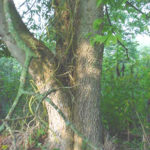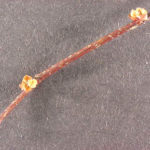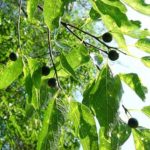hackberry (Celtis occidentalis)
Family: Ulmaceae
Categories |
Images |
|---|---|
| Form:
Small to medium sized tree reaching 30 to 40 ft. and 1 1/2 ft. in dbh |
|
|
Leaves: Shape: inequilateral rounded base Margin: serrate, but entire below the middle Texture: pubescent below Variation: 3 main veins originating at petiole |
|
| Bark:
Brownish gray with a smooth surface and characteristic warts and ridges. |
|
| Twigs and Buds:
Zigzagging and slender, reddish brown in color. Buds are small and acute. |
|
| Flowers and Fruit:
Flowers are small and green in color. They are produced on stalks near the twig. Fruits are a drupe with a long stem. The drupe has an ovid shape and a purplish to dark red color. |
|
| Distinguishing Characteristics:
Tree has warty bark and a characteristic fruit. The leaf usually is serrated above the middle with 3 main veins. |
|
| Range:
Central Wisconsin east to central New York. South to northern Georgia and west to central Arkansas. |
|
| Silvics:
Occurs on rich, moist alluvial soils. However, it does occur on drier sites as well as on limestone outcrops. |
|
| Ecological and Cultural Importance:
The wood is used as substitutes for white ash, hickory, and elm. It does have a low timber value. The fruit is eaten by a variety of birds and mammals. Especially notable species include: wild turkey, ringneck pheasant, mocking bird, and fox squirrels. Also commonly called beaverwood. |



